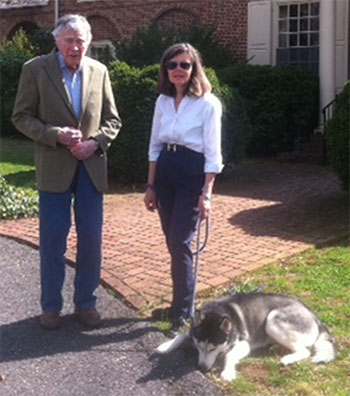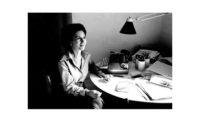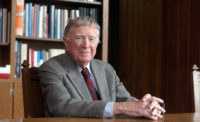We mourn the death of Vincent Scully, the eminent historian who brought a vital, empathetic, and inventive socio-cultural approach to the writing about and teaching of architecture and art. In honor of Scully, who died November 30 at age 97, we asked architects, historians, and former students who knew him from Yale University, and later from the University of Miami, to discuss Scully’s influence on their thinking and appreciation of architecture.
We conclude with a reminiscence of his later years from his wife, architecture and design historian Catherine (Tappy) Lynn. We shall continue to add new tributes over the next several days. For more details, see Paul Goldberger’s reflections on Scully’s legacy. Also, view a trailer below of the documentary about Scully’s life by Checkerboard Films.
ROBERT A.M. STERN:
I really got to know Vince Scully well in the early 1960s after I helped organize his teaching assistants to meet the demands of his Modern Architecture class that had swelled to 400 students. We'd have lunch after many of his classes at his favorite place, Sullivan's, whose owner he called Jocko, on Chapel Street—it was a sort of high-class dive bar. When one day I told him I was very interested in George Howe, and he almost had an apoplectic fit: he had only unkind things to say about Howe—whom I'd never met, but I'd become fascinated by because of his evolution from a skilled and widely admired traditional house architect into a Modernist, and then by his gradual reversion with houses like Square Shadows and Fortune Rock. Scully knew him from his early teaching days, when, from 1950 to 1956, Howe was Chairman of the Department of Architecture. I believed that Howe had taken Yale's architecture program out of the doldrums and made it the first-rate place that I knew as a student. Scully thought he had sowed dissension among the faculty and left it with no acceptable structure. When I finally finished my Howe book, Vince, by now a close friend, and always the most gracious person on earth, complimented me on it. I think he meant it. In any case a compliment from Vince meant the world to me. I thought I'd died and gone to heaven. Such compliments were really important to me and to so many architects of my generation: we were always doing our best work for Vince.
SID BASS:
Vince Scully taught us that architecture reflects who we are, and it also shapes who we are.
NEIL LEVINE:
I was inspired as an undergraduate by Vincent Scully’s writings to want to do my graduate studies with him, and fortunately was able to. He was an extraordinary teacher, not only in large lecture courses but also, in a different way, in small-group settings. He was a fabulous adviser, though not in the typical hands-on way. He saw his role, or at least that’s how I understood it, as providing intellectual guidance, personal sympathy, and encouragement, and being the leader in a cooperative adventure. He was a great mentor whom one could always count on for the things graduate school advisors are supposed to do. He became a good, beloved friend. He was warm and affectionate, with whom discussions of the most serious art-historical issues were never far from breaking into hilarious laughter. His sense of humor was as profound and catching as his sense of the meaning and purpose he believed architecture and art could and should convey. Every moment with him was tense with thought and suggestion. He had the rare ability to change the way one thought in an instant of searing insight. Knowing him was a unique privilege that only confirmed the power of influence one knew he exerted on the culture, and especially the architecture around him.
ALEXANDER GORLIN:
Scully presented a humanistic, unified field theory of architecture. Architectural history was not a dry recitation of facts and buildings, but a living, breathing network of constructions and landscapes in a “dialogue over time and space.” The Greek Temple “gestured to the distance horns of the sacred mountain” and the statue of Hercules “looked back at his labors building the gardens of Vaux-le-Vicomte.” On Chapel Street in New Haven, Louis Kahn’s museums “answered” Paul Rudolph’s heroic Art & Architecture Building, creating a community of humanly scaled architecture that defined the urban fabric of the city. For architects this was an extraordinary revelation, that the entire history of architecture was available for inspiration in the creation of the monuments of tomorrow. One consequently had an obligation to the landscape or city in which architecture was to dwell. It was not simply a modernist, self-referential object, but reverberated in a larger context of people and places. This profound humanism of architecture is sorely missed today when students learn parametric algorithms, and rapacious developers ravage our cities with monstrous towers that block the sun and steal the sky.
ANDRES DUANY:
Almost immediately upon his arrival, Scully became fascinated by the Florida that many of us don’t notice. He was enamored of the small-scale ranch houses of the 1950s, those built by the Mackle Brothers in Key Biscayne and Ft. Lauderdale. He found them dignified, tropical, and exceedingly convenient. Tappy and he chose to live in one of them in Coral Gables, and they both dearly loved it. Until I witnessed this, I never gave this vernacular of ours any credence. Now I too, love them and much more so than the pretentious traditional or modernist villas that know only how to show off.
He never ceased to amaze us with his love and insight for our South Florida architecture. In the end he was even excited by our new downtown skyline. There has probably never been such an open-minded professor of architecture. He was completely free of ideology, but with a prejudice towards the modest.
ELIZABETH PLATER-ZYBERK:
Vincent Scully taught at the University of Miami for almost 20 years after retiring from Yale. An inspiring and renown teacher and author, he and his wife, Tappy Lynn, who taught architectural history courses at the School of Architecture, too, adopted our faculty and encouraged us to engage the culture of place in teaching and practice. The 1996 book Between Two Towers chronicles his support for his new colleagues. Arriving just three years after the program became the School of Architecture, his presence among us gave impetus to faculty and students alike to seek a regional identity. He loved the diversity of Miami culture, its affinity with the Caribbean, and he encouraged us to emphasize these as a distinction. We remember gratefully his demanding intellect, generous mentoring, and outrageous sense of humor.
CATHERINE (TAPPY) LYNN:

Photo courtesy Catherine Lynn
Vince had to leave our dear little house in New Haven because the Parkinson's made it impossible for him to climb the stairs, and he couldn't bear to adapt that house in an ugly way to accommodate him on the first floor. Plus he knew we had fine quarters for his care in the Lynchburg house my parents had left me. So we came to live here in the fall of 2011. But he has ached for New Haven and for Yale ever since.
Vince did grow to love our home in Lynchburg and he shaped it to suit us. We moved in a lot of the New Haven furniture, and he brought his beloved prints and books, his native American pots and Kachina dolls to transform the rooms inside. Outside he planted way too many trees—a veritable Scully memorial forest. Nor could he bear to leave his row boats behind, so they're enshrined in their own little shed here, though there was no where to row them. Still, he could look at them. Then he shaped our three acres with beloved classical forms—a pergola, a pool, a folly. Not quite Hadrian's Villa, but surely, if modestly, honoring it.
So until the very last month, he could and did enjoy this place. He made new, very southern, friends, did a little writing, cultivated a love of opera that revived memories of his mother—a coloratura soprano. And he read incessantly. Everything. Until his vision failed rather suddenly, and then his heart, only a month before he died.
Watch a trailer for the 2010 documentary on Vincent Scully by Checkerboard Films.





Post a comment to this article
Report Abusive Comment